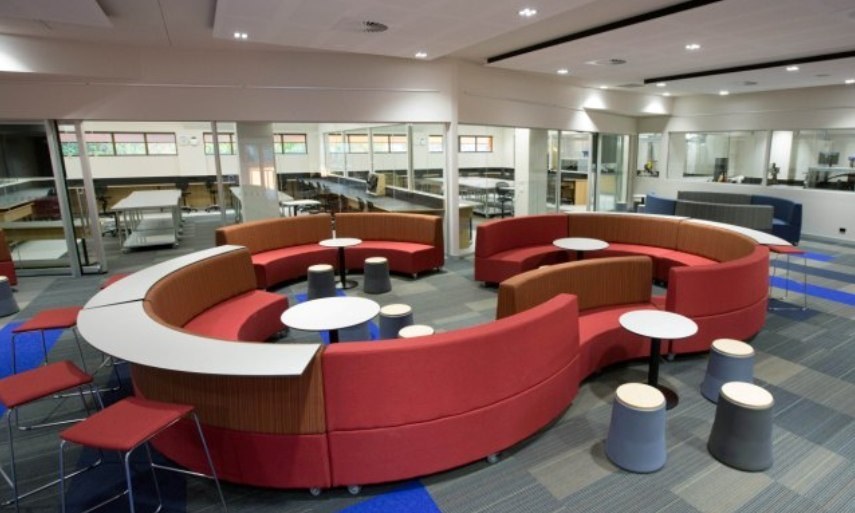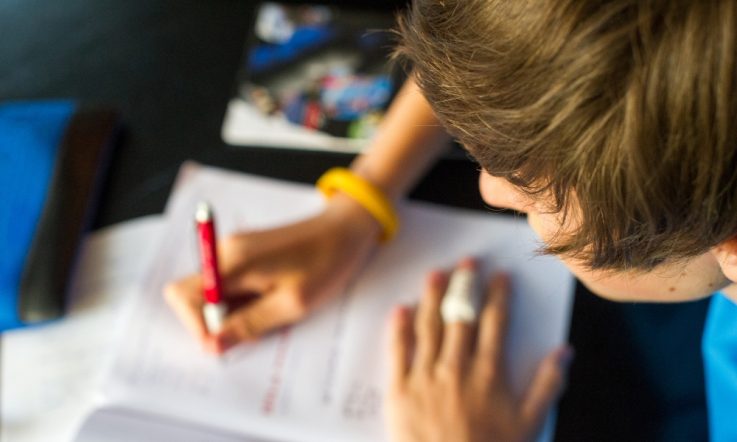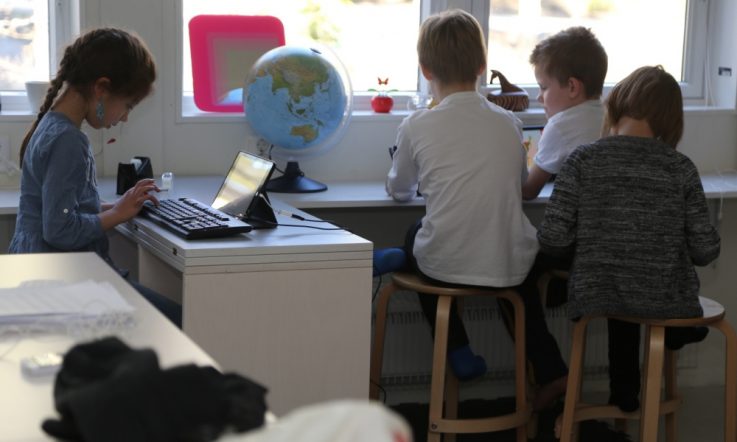This podcast from Teacher magazine is supported by the University of Wollongong. UOW's flexible Master of Education course, combining face-to-face and online learning, is more achievable than ever for educators and professionals who want to upskill while working. Apply now at go.uow.edu.au/master-ed
Hello, I'm Jo Earp. What sort of learning environments does your school have? Are you making the best use of your teaching space? My guest on The Research Files this month is Wes Imms, Associate Professor in the Melbourne Graduate School of Education and Lead Chief Investigator of the Innovative Learning Environments and Teacher Change project. Over the next four years the research team will be investigating how teachers are using these environments to improve student learning outcomes, and they'll be sharing strategies and best practice.
Jo Earp: Let's start first of all then by looking at that terminology: when you say ‘innovative learning environments' what exactly do you mean?
Wes Imms: People mistakenly think that innovative learning environments is the same as the 1970s open classroom-type structures; they are quite different. Open classrooms tended to have sort of a free range, kids go anywhere feel to them – very large open spaces. Innovative learning environments differ because the intent of how the space is used differs.
Innovative learning environments can be characterised as having very flexible physical spaces. So, you'll actually find that within a particular place that you have got everything from large spaces for didactic teaching (where a teacher stands at the front and teaches everybody), through to facilities for group work, through to breakaway spaces for groups of say 10 students to move, through to very quiet spots where two people can sit and work, and even through to almost retreat-type huddle spots where a person can go and work.
That's the physical characteristics of [innovative learning environments]. In terms of other type of affordances, you're also looking at a really high level of information computer technology infusion – so, good wi-fi, lots of whiteboards, lots of interactive spaces and access to all of the fantastic things that technology provides for kids to be able to move.
Overarching all of that, you do go back to the basic principle of the open classroom movement which is actually that kids have to be allowed to find the people they need to work with to solve particular problems, they need to be able to work with people they need to work, they need to be given facilities to be able to move off and to do things when they feel like they need them. So, a particular teacher won't necessarily be the best teacher to solve a particular problem, even though students are timetabled to be with that teacher. These sorts of facilities allow the kids to move off and find those teachers.
The other issue, of course, is it works the other way around as well. The teachers, if they're teaching something, can actually then go and isolate children and students in particular places to focus on very particular tasks. So it's that whole notion of being, as the name says, very flexible and that is the characteristic of an innovative learning environment.
JE: Now, this is the four-year Innovative Learning Environments and Teacher Change project. It was launched this year and it'll run until 2019. You're the Lead Chief Investigator, but it's what's called a ‘linkage project' isn't it? So, can you just give a brief overview of the kind of people and organisations involved?
WI: We are linking up with industry partners, manufacturing partners, policy partners and school partners in this. We have about 15 different partner organisations – it's actually one of the biggest ARC (Australian Research Council) linkages ever run. The 15 partner organisations span policy, so we have people like the New Zealand Ministry of Education, the Queensland Education Department and New South Wales … So, those policy people are very interested in this project because they're putting millions of dollars into designing innovative learning environments. And while the designs are fantastic and they've been built and put out there, the worry is are they actually being used the way that they can be used? You know, the huge potential they have. That's why they are investing in the project.
We also have partnerships with people like Steelcase furniture from the United States, who obviously have offices here in Melbourne, and Telstra Australia, Hayball architects, people like that. Ecophon which is a Swedish acoustics firm, they're very interested in the industry side of it – so if you're going to build these spaces what is it the clients need to make them work better and how can these sort of people develop their own products to fit better in?
Then of course the third category of people we're working with are what we call research-focused schools. We have Woodleigh School here in Victoria, the Australian Science & Mathematics School in South Australia, we've got Anglican Church Grammar School (Churchie) in Brisbane. These are schools that have got an established history of wanting to undertake research to improve the practice within the school and each of those have got a particular interest in the built environment.
Then of course there's the research team. We have something like 23 researchers, eight Chief Investigators of which I'm just one, we've got Research Fellows situated in Queensland, New Zealand, and we have at the moment five PhDs but we might well have seven soon, to undertake all this work. So, it's a huge team.
JE: Just a namecheck there, the ARC, for those that are not aware that's the Australian Research Council isn't it that's the main funder. As we mentioned there it's four years, lots of different things happening in different phases of the project. There are three stages, what will the focus be for each of those?
WI: Ultimately what the project is about is to get teachers to actually teach us what works and what doesn't work in these environments. Some teachers are fantastic at using these environments, some don't have any idea of what they are capable of doing, and there a lot that are in between. So, the project is designed to actually illicit from teachers the best practices and to use those best practices then to develop up strategies to allow us to share those practices more widely. And then finally, if we do share the strategies more widely do they work? Are they helping teachers to use space better as a pedagogical tool?
So, the project has three stages. The first stage for about a year-and-a-half is baseline data. In other words, finding out what's actually happening out there. How many of these environments actually exist? What do they look like? How are teachers feeling like they use them – do they feel like they use them well or not? And also then sending out the PhD students to do case studies to say well ‘in reality what's really happening …'
From that we get not only an idea of what's happening out there, we also get an idea of the sorts of things that are really working well, those innovative practices that teachers are developing in these spaces. Of course, we can marry those with theoretical practices that we as researchers think ought to happen as well. From that we build up a bunch of strategies.
The second phase is making those strategies into what we call a tool box. It's a whole bunch of professional development learning, it's a bunch of resources, it's a bunch of all sorts of activities that teachers can undertake to use these spaces better to help them improve their practice. And that's the middle section.
The third section is then trialling those in as many schools as we can – let's say 1000, across New Zealand and Australia, to say ‘Okay, if you go to a regional centre, if you go to an inner city centre, if you go to a private school, if you go to a public school, do these strategies work? Do they help teachers use space better?'
JE: What are the implications then for educators, school leaders and, of course, we haven't mentioned yet but the students?
WI: The product from this, while it's both theory-based it's also extremely important that it's practice-based and it's focused for teachers, because actually that's where it matters the most. Ultimately, what we're after is improvement in student learning.
In research terms we have two dependent variables – in other words, the dependent variable is the thing you're trying to effect change in. And there are two things we're looking at, one is teacher's mind frames: how do we get teachers to reconceptualise teaching to make the most of space as one of the pedagogical tools? And the second dependent variable is students' deep learning: if we do that [get teachers to reconceptualise teaching], then does that actually make a difference in students' deep learning? By deep learning we mean a lot of schools are very good at what you call ‘superficial' learning, which is teaching towards getting good ATAR scores, or doing well on the NAPLAN test. Studies show that often students, when they get given those tests, six months afterwards score much lower than they did previously. That's a characteristic of superficial learning where you're teaching towards a result.
Deep learning is where you not only do that but you also add to it mechanisms whereby students are able to utilise that knowledge in a myriad of ways, and apply that in different contexts and settings and effectively ‘learn to learn'. So, in six months' time not only do they remember the basic concepts but also by then they would have moved those concepts into a myriad of other different aspects and parts of their own personal learning. That's why it's important, because effectively when it comes down to it we're trying to improve the deep learning characteristics embedded within these spaces.
…
Some schools are still designing and still building, in fact infrastructure investment is increasing in schools. We went through the Building the Education Revolution, where it was something like $14 billion put into schools, largely because of the speed that it had to be done it was done without enough consultation with teachers. What's happening now is schools, because they're falling down and need fixing, if you're going to build let's build to latest best practice. For instance, in New Zealand they're mandating innovative learning environments as the school model.
For that reason it is part of the project and part of our thinking in our Learning Environments Applied Research Networks (LEaRN – that's the research group here at Melbourne University that is doing all this sort of work) – our central thrust is to make sure that there is a really strong alignment between the design of a facility and the pedagogical requirements, and the learning has to come from it. So, ideally what happens is teachers talk to architects about the space and architects then design it well and the teachers move in and use it and then comes that long-term, what I call, ‘inhabitation'. That is, you're working with teachers over a period of time to maximise the usefulness of the space.
So, it's not as simple as saying ‘an architect will give us a lovely school, now we've got to move into it', it ought to be that teachers are actively involved at the very first conceptualisation, through to still rethinking it five/10 years after having moved in. That's truly what this project ought to be trying to facilitate.
JE: Finally then, before we finish, I know that you're very keen to hear from educators and students. How can they get involved in the next four years?
WI: Feel free to contact us and have a conversation with us if you'd like to about what's happening. There are phases of the actual upcoming research that will be opened to more than just the partner organisation schools – in the first two phases of the project we're working on we have to restrict ourselves to partner organisation schools, but within that we have more than 6000 schools at our disposal. But in the final phase we're very keen on having really good cross-representation of space – if you think that your school would be a really good site to trial some of these strategies in 2018 then contact us now and get on our mailing list.
JE: Excellent. We'll watch with interest the continuation and the progress in the project, but for now Wes Imms thank you very much for joining The Research Files.
WI: A pleasure, thank you.
You've been listening to a podcast by Teacher magazine, supported by the University of Wollongong - stands for purpose. UOW's Master of Education is more achievable than ever for educators and professionals, who want to upskill while working. The flexible course combines face-to-face and online learning. Apply at go.uow.edu.au/master-ed
Check out the full podcast transcript and related reading at www.teachermagazine.com.au. To download all the Teacher magazine podcasts for free head to acer.ac/teacheritunes or www.soundcloud.com/teacher-acer
Do you consider your learning space to be one of your pedagogical tools?
Are you making the most of the learning spaces available to you?
When designing your learning spaces, do you consider the activities that will be happening in them?



